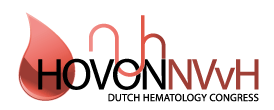Treatment with immunochemotherapy decreases the metabolic fitness of CD19 CAR T-cells in DLBCL
Treatment with CD19 Chimeric Antigen Receptor (CAR) T-cells can offer a curative treatment option for patient with relapsed/refractory diffuse large B-cell lymphoma (DLBCL). Yet, despite the successes of CAR T-cell therapy in several hematological malignancies, in r/r DLBCL only ~40% of patients have durable response to anti-CD19 CAR T-cell therapy. This study aims to investigate whether prior treatment with immunochemotherapy negatively affects metabolic fitness of CD19 CAR T cells derived from patients with DLBCL, potentially reducing CAR T-cell efficacy.
Peripheral blood mononuclear cells (PBMCs) from N=25 DH/TH LBCL patients enrolled in the HOVON 152 trial were used which were collected at three timepoints during treatment: after one cycle of R-CHOP (ENR), after two cycles of DA-EPOCH-R (MID) and after five cycles of DA-EPOCH-R (EOT). HOVON 152 samples were analyzed using pairwise comparisons. 10 age-matched healthy donors (HDs) were included as a control. Anti-CD19 CAR T-cells were manufactured according to protocols described previously. Flow cytometry was used to assess CAR T-cell phenotype and metabolic characteristics. Cytotoxic potential against Raji cells was determined using bioluminescence. CAR T-cells were stimulated with irradiated Raji for 3 subsequent weeks to assess proliferative capacity. Cytokine secretion was measured using a Th1/Th2 Cytokine CBA kit.
CD19 CAR T-cells manufactured at ENR had a significantly lower percentage of effector memory cells compared to MID (13.07% vs 19.82%, SEM± 1.72, p=0.018) and EOT timepoints (13.07% vs 25.97%, SEM± 3.05, p=0.0287). Mitochondrial mass and mitochondrial membrane potential (ΔΨ) were significantly increased in EOT samples compared to HDs in both CD4+ and CD8+ CAR T-cells. The ratio of ΔΨ to mitochondrial mass was significantly lower in EOT samples compared to MID samples in CD4+ CAR T-cells (MFI 0.061 vs 0.027, SEM± 0.01, p=0.0366). Glucose uptake was significantly increased in CD4+ EOT CAR T-cells compared to HDs (rel. MFI 0.7757 vs 1.419, SEM± 0.24, p=0.0437). No significant differences in cytotoxic capacity were found. Fold proliferation was significantly higher in HD CAR T-cells than in DLBCL CAR T-cells in the first week (fold prolif. 2.324 vs 1.090 vs 0.903 vs 1.191). IL-2 secretion was significantly higher in HDs compared to MID samples (3965 pg/mL vs 1552 pg/mL, SEM± 614.4, p=0.0029).
This study shows that CAR T-cells derived from patients with DLBCL contain more depolarized mitochondria with a lower ΔΨ to mitochondrial mass ratio than healthy donor CAR T-cells. Furthermore, CD19 CAR T-cells contain more depolarized mitochondria as treatment with DA-EPOCH-R progresses. Even though the cytotoxic capacity was not reduced, it appears chemotherapeutic treatment has a detrimental effect on proliferative capacity of CAR T-cells. Future research will focus on improving the efficacy of DLBCL-derived CD19 CAR T-cells.

